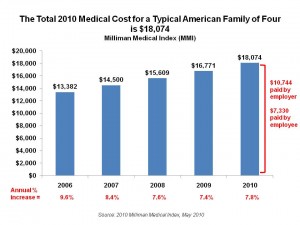Today, $18,074 could cover…
- A new 2010 Honda Civic
- A year of college at Hampton University in Virginia
- The per capita income in Waterloo, NY.
Or, you could cover health insurance for a typical family of four in America.
 In the past year, the average cost of health care for a family of four in the U.S. has increased by $1,303, the large single dollar increase seen in the past 10 years since the start of the Milliman Medical Index (MMI).
In the past year, the average cost of health care for a family of four in the U.S. has increased by $1,303, the large single dollar increase seen in the past 10 years since the start of the Milliman Medical Index (MMI).
The total medical cost for a family of four is $18,074 in 2010. Employers will pay, on average, 59% of the total, and employees bear 41% – a shared personal health expense of $7,330. This is the first year that employer contributions exceed $10,000.
As the chart shows on the bottom tier, health care costs continue to escalate well above general price inflation (the CPI). In 2010, the medical cost increase was 7.8%. Milliman calculates that the effective annual trend rate between 2005 and 2010 is 8.2%.
The MMI aggregates health benefit costs for employers and employees including the cost of services paid by employer health benefit programs plus the costs spent by employees including payroll contributions for medical coverage, and at the point-of-service, deductibles, coinsurance, and copayments. The number accounts for all payments to health providers, excluding administrative costs of health plan premiums. Providers include hospitals, physicians, and pharmacies, and include the copayments borne by employees for these services.
Health Populi’s Hot Points: How will health reform impact the MMI? Milliman anticipates that required benefit changes under the health plan will shift costs from employees to employers. Depending on their profit margins, this could motivate some employers to erode benefits in order to continue to cover health for employees. But employees could feel the pinch, too, as more of their dependents up to age 26 receive access to coverage; the Washington Post’s analysis explains that employee premiums could increase as a result.
This should also be a driver for innovation in how health plans are designed and delivered. In 2014, the Federal government takes on a greater role in providing coverage to the uninsured through Medicaid expansion and the creation of health insurance exchanges. At the same time, employers will take on the expansion of coverage for dependents up to age 26. This will require re-imagining the health benefit.
Under this reality, the status quo of health plan benefit design is not fiscally sustainable. There is ample opportunity for a new-new kind of health plan in and beyond 2014. I’m aware of several of these in start-up mode. Stay tuned for the disruption of Health Plans As We Know Them.




 Thank you FeedSpot for
Thank you FeedSpot for